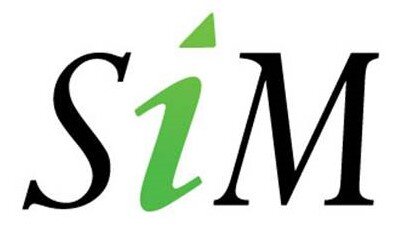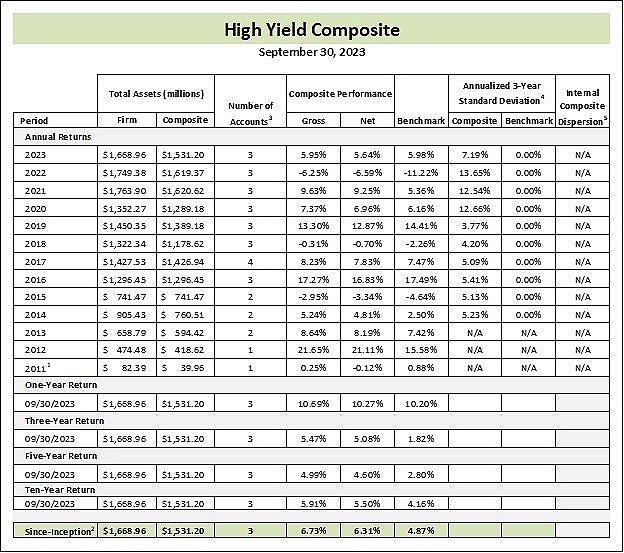SiM High Yield Composite Index
September 30th, 2023
Performance reflects the unannualized performance from March 1, 2011 to December 31, 2011
Composite inception date March 1, 2011, annualized returns
Reflects number of accounts in composite at end of period.
For periods with less than 36 months of composite performance, no 3-year standard deviation measurement is available.
Information is not statistically meaningful due to an insufficient number of portfolios in the composite for the entire year. During the periods presented with multiple accounts, one account represented approximately 85-95% of the aggregate composite assets. This large account is an open end mutual fund, and as such, may experience more frequent, and more significant, cash flows than other non-open end mutual fund accounts in the composite.
Strategic Income Management, LLC claims compliance with the Global Investment Performance Standards (GIPS®) and has prepared and presented this report in compliance with the GIPS standards. Strategic Income Management, LLC has not been independently verified.
Strategic Income Management, LLC is an independent SEC registered investment adviser. The firm maintains a list of composite descriptions, which is available upon request.
Composite Strategy and Fee Disclosures:
The Strategic Income Management High Yield Composite (the “High Yield Composite”) contains all discretionary fee paying accounts that invest, under normal circumstances, at least 80% of the their net assets in non-investment grade securities and/or financial instruments that provide exposure to noninvestment grade securities. Non-investment-grade securities are securities rated at or below Ba or BB by Moody’s, S&P or Fitch or, if unrated, determined by Strategic Income Management, LLC to be of comparable quality. The non- investment grade securities in which accounts in the High Yield Composite may invest include: corporate bonds, convertible securities, preferred stock, bank and senior loans, securities of foreign issuers, emerging market debt and Rule 144A securities. Some accounts in the High Yield Composite utilize currency futures to hedge non U.S. dollar currency exposure for securities denominated in non U.S. dollars. Some accounts may also utilize credit default swaps (CDS) on a limited basis. Neither currency futures nor CDS are major components of the High Yield strategy or of accounts in the High Yield Composite. Portfolios in the High Yield Composite may contain international securities. There are no known material differences in exchange rates or valuation sources among the portfolios in the High Yield Composite. Specific investment guidelines may differ between accounts in the High Yield Composite, and therefore not all accounts in the High Yield Composite will hold the same securities or the same weightings in the same securities.
For comparison purposes the High Yield Composite is measured against the ICE BofA US High Yield Index (the “Benchmark”). The High Yield Composite was created November 1, 2012. The inception date of the High Yield Composite is March 1, 2011. Returns are presented gross and net of management fees and include the reinvestment of all income. Net performance was calculated using the actual sub advisory management fees applicable to those accounts included in the High Yield Composite, applied monthly. Actual sub advisory management fees for the accounts in the High Yield Composite vary depending upon account size and other factors, and currently range between 0.40% to 0.30% on amounts over $1 billion. The standard investment advisory fee applicable to non-mutual fund accounts in the High Yield Composite is 0.40%. Actual investment advisory fees incurred by clients may vary and returns will be reduced by investment advisory fees actually incurred. Further information regarding investment advisory fees is described in Part 2a of the firm’s Form ADV.
The U.S. Dollar is the currency used to express performance. The minimum account size for the High Yield Composite is $15 million.
Benchmark Disclosures:
The ICE BofA US High Yield Index tracks the performance of US dollar denominated below investment grade rated corporate debt publicly issued in the US domestic market. To qualify for inclusion in the index, securities must have a below investment grade rating (based on an average of Moody's, S&P, and Fitch) and an investment grade rated country of risk (based on an average of Moody's, S&P, and Fitch foreign currency long term sovereign debt ratings). Each security must have greater than 1 year of remaining maturity, a fixed coupon schedule, and a minimum amount outstanding of $100 million. Original issue zero coupon bonds, "global" securities (debt issued simultaneously in the eurobond and US domestic bond markets), 144a securities and pay- in-kind securities, including toggle notes, qualify for inclusion in the Index. Callable perpetual securities qualify provided they are at least one year from the first call date. Fixed-to-floating rate securities also qualify provided they are callable within the fixed rate period and are at least one year from the last call prior to the date the bond transitions from a fixed to a floating rate security. DRD-eligible and defaulted securities are excluded from the Index.
Regulatory Disclosures:
Performance shown represents total returns that include income, realized and unrealized gains and losses. Gross returns shown do not reflect the deduction of investment advisory fees. Investment returns will be reduced by investment advisory fees and other expenses incurred during portfolio management. Past performance is not indicative of future results.
Methodology Disclosures:
Gross performance is presented net of transaction costs. Net of fee performance was calculated using actual fees applied monthly. High Yield Composite performance is presented net of foreign withholding taxes on dividends, interest income, and capital gains. Withholding taxes may vary according to the investor’s domicile. High Yield Composite returns represent investors domiciled primarily in the United States. For non-US domiciled portfolios, performance is calculated without including the effects of currency share class hedging.
Non-US domiciled investors investing in a share class that is hedged back to their local currency may have returns different than the composite returns. Strategic Income Management has defined a Significant Cash Flow as 15% of a portfolio’s value at the time of the cash flow. Policies for valuing portfolios, calculating performance, and preparing compliant presentations are available upon request.
Variance Disclosures:
The composite dispersion presented is an asset-weighted standard deviation calculated using accounts in the High Yield Composite the entire year. During the periods presented with multiple accounts, one account represented approximately 85-95% of the aggregate composite assets. This large account is an open end mutual fund, and as such, may experience more frequent, and more significant, cash flows than other non-open end mutual fund accounts in the composite.
The 3-Year Standard Deviation represents the annualized standard deviation of actual High Yield Composite and Benchmark returns, using the rolling 36-months ended each year-end. The 3-Year Standard Deviation of the High Yield Composite and the Benchmark returns are not presented for some periods because the High Yield Composite strategy had less than three years of history for those periods.

